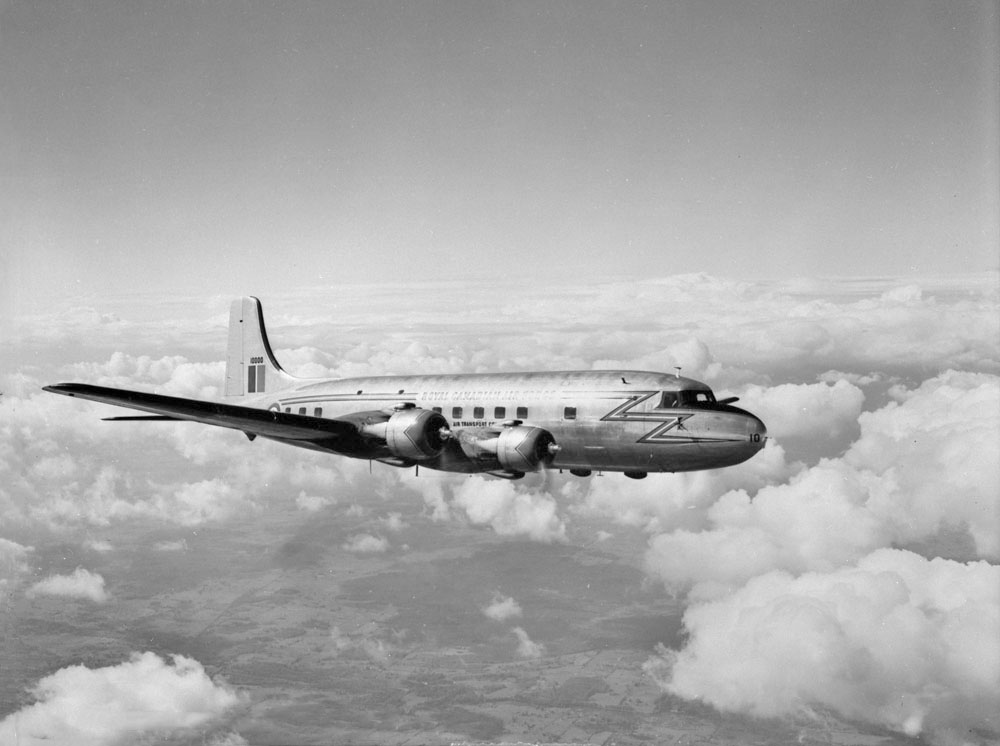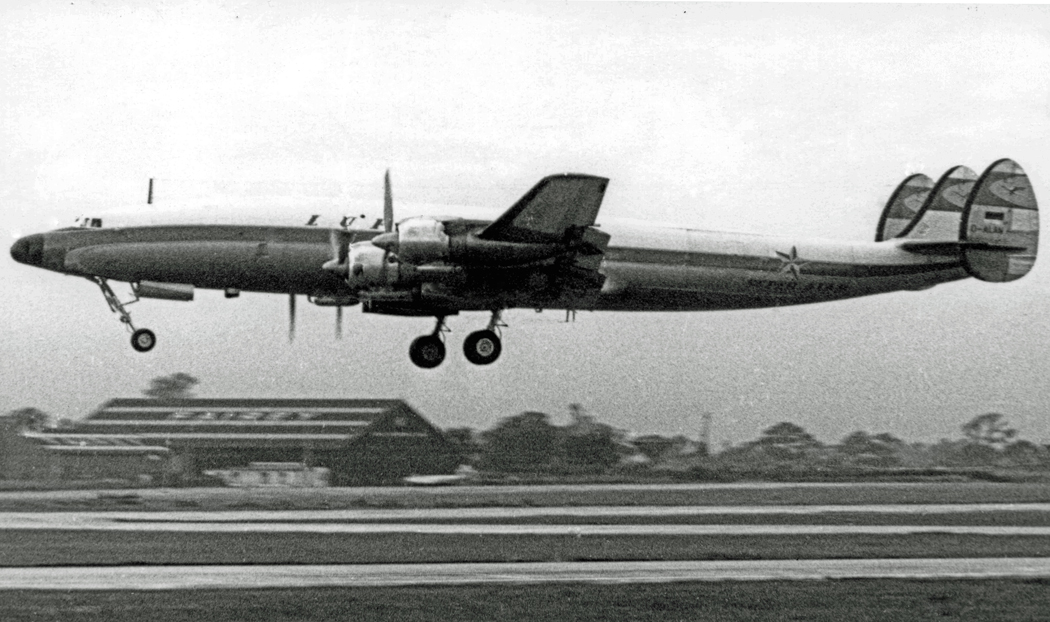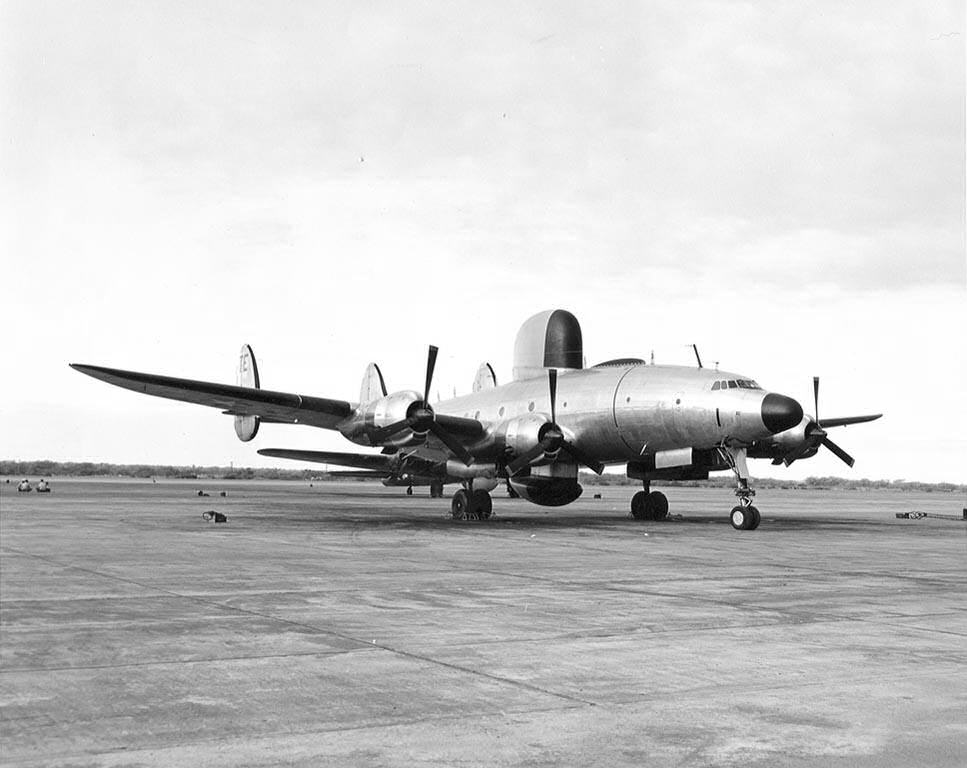|
L-649 Constellation
The Lockheed L-649 Constellation was the first real civilian version of the Lockheed Constellation line, as the Lockheed L-049 Constellation was a simple redesign from the military Lockheed C-69 Constellation. The L-649 was planned to be the new standard version of the Constellation, but the L-749 Constellation, a co-jointly produced improved derivative, was chosen over the L-649 by most airlines. Most of the few L-649 aircraft built were delivered and operated by Eastern Air Lines. History When Curtiss-Wright offered an improved version of the Wright R-3350 Duplex-Cyclone, Lockheed began developing an improved version of the L-049 Constellation airliner to be powered by this engine. The new project was designated L-049-84. In addition to the engine change, the wing and fuselage structure were strengthened to allow an increased gross weight. The cabin was redesigned and made more luxurious, incorporating changes such as retractable overhead sleeping berths, modernised air conditio ... [...More Info...] [...Related Items...] OR: [Wikipedia] [Google] [Baidu] |
Eastern Air Lines
Eastern Air Lines, also colloquially known as Eastern, was a major United States airline from 1926 to 1991. Before its dissolution, it was headquartered at Miami International Airport in an unincorporated area of Miami-Dade County, Florida. Eastern was one of the " Big Four" domestic airlines created by the Spoils Conferences of 1930, and was headed by World War I flying ace Eddie Rickenbacker in its early years. It had a near monopoly in air travel between New York (state), New York and Florida from the 1930s until the 1950s and dominated this market for decades afterward. During airline deregulation in the late 1970s and early 1980s, labor disputes and high debt loads strained the company under the leadership of former astronaut Frank Borman. Frank Lorenzo acquired Eastern in 1985 and moved many of its assets to his other airlines, including Continental Airlines and Texas Air. After continued labor disputes and a crippling strike in 1989, Eastern ran out of money and was liq ... [...More Info...] [...Related Items...] OR: [Wikipedia] [Google] [Baidu] |
Chicago And Southern Air Lines
Chicago and Southern Air Lines (C&S) was a United States airline that started life as Pacific Seaboard Air Lines in California and was organized on June 15, 1933. Following the move from California, the airline's headquarters were initially located in St. Louis, Missouri and were then moved to Memphis, Tennessee, which also served as a hub for the carrier. C&S was merged into Delta Air Lines in 1953, thus providing Delta with its first international routes. History The first service was operated by Pacific Seaboard Air Lines on June 23, 1933, in Carleton Putnam's single engine Bellanca CH-300 "Miss San Jose." Putnam held a Transport Pilot's license. Three Bellanca CH-300s were flown in the California operation. The new airline only flew passengers on the West Coast of California on "The Scenic Route." This route was up the coast of California from Los Angeles (Grand Central Air Terminal at Glendale) to San Francisco's Mills Field. Stops were made at seven destinations located ... [...More Info...] [...Related Items...] OR: [Wikipedia] [Google] [Baidu] |
Douglas DC-6
The Douglas DC-6 is a piston-powered airliner and cargo aircraft built by the Douglas Aircraft Company from 1946 to 1958. Originally intended as a military transport near the end of World War II, it was reworked after the war to compete with the Lockheed Constellation in the long-range commercial transport market. More than 700 were built and many still fly in cargo, military, and wildfire control roles. The DC-6 was known as the C-118 Liftmaster in United States Air Force service and as the R6D in United States Navy service prior to 1962, after which all U.S. Navy variants were also designated as the C-118. Design and development The United States Army Air Forces commissioned the DC-6 project as the XC-112 in 1944. The Army Air Forces wanted a lengthened, pressurized version of the DC-4-based C-54 Skymaster transport with more powerful engines. By the time the prototype XC-112A flew on 15 February 1946, the war was over, the USAAF had rescinded its requirement, and the aircra ... [...More Info...] [...Related Items...] OR: [Wikipedia] [Google] [Baidu] |
Canadair North Star
The Canadair North Star is a 1940s Canadian development, for Trans-Canada Air Lines (TCA), of the Douglas DC-4. Instead of radial piston engines used by the Douglas design, Canadair used Rolls-Royce Merlin V12 engines to achieve a higher cruising speed of compared with the of the standard DC-4. Requested by TCA in 1944, the prototype flew on 15 July 1946. The type was used by various airlines and by the Royal Canadian Air Force (RCAF). It proved to be reliable but noisy when in service through the 1950s and into the 1960s. Some examples continued to fly into the 1970s, converted to cargo aircraft. Design and development Canadair Aircraft Ltd. took over the Canadian Vickers Ltd. operations on 11 November 1944. Besides the existing Consolidated PBY Canso flying patrol boats in production, a development contract to produce a new variant of the Douglas DC-4 transport was still in effect. The new Canadair DC-4M powered by Rolls-Royce Merlin engines mounted in Rolls-Royce Universa ... [...More Info...] [...Related Items...] OR: [Wikipedia] [Google] [Baidu] |
Bristol Britannia
The Bristol Type 175 Britannia is a retired British medium-to-long-range airliner built by the Bristol Aeroplane Company in 1952 to fly across the Commonwealth. During development two prototypes were lost and the turboprop engines proved susceptible to inlet icing, which delayed entry into service while solutions were sought. By the time development was completed, "pure" jet airliners from France, the United Kingdom, and the United States were about to enter service, and consequently, only 85 Britannias were built before production ended in 1960. Nevertheless, the Britannia is considered one of the landmarks in turboprop-powered airliner design and was popular with passengers. It became known as "The Whispering Giant" for its quiet exterior noise and smooth flying, although the passenger interior remained less tranquil. [...More Info...] [...Related Items...] OR: [Wikipedia] [Google] [Baidu] |
Lockheed L-1649A Starliner
The Lockheed L-1649 Starliner was the last model of the Lockheed Constellation line of airliners. Powered by four Wright R-3350 TurboCompound engines, it was built at Lockheed's Burbank, California plant from 1956 to 1958. Design and development Development of the Starliner began when Lockheed designed the L-1449 in response to the Douglas DC-7C Seven Seas.Breffort, Dominique. Lockheed Constellation: from Excalibur to Starliner Civilian and Military Variants. Histoire and Collecions, 2006. p.112 to 117 Powered by four 5500 hp Pratt & Whitney PT2G-3 turboprop engines, the L-1449 would have cruised faster than the DC-7C with comparable range with of fuel in a new wing. Pratt & Whitney dropped the PT2 project in March 1955 due to expected unreliability, high specific fuel consumption and high operating costs, though the T34 military version of the engine powered the Douglas C-133 freighter, which was also plagued with unreliability. The L-1449 would have been about lon ... [...More Info...] [...Related Items...] OR: [Wikipedia] [Google] [Baidu] |
Lockheed L-1249 Super Constellation
The Lockheed L-1249 Super Constellation was a turboprop-powered version of the Lockheed Constellation aircraft family. Built in 1954 and 1955, the aircraft were used as prototypes for possible future military transport aircraft for both the United States Air Force and United States Navy. Both aircraft saw very short lives and the airframes were later used to build L-1049 Super Constellations. Design and development On 18 August 1950, the United States Navy signed a contract for 11 military transport versions of the Lockheed L-1049. The aircraft were to have been convertible troop/cargo transports, based on the model L-1049B (which was already being constructed as the PO-2W Warning Star). The R7O-1 would have also featured round portholes in place of the rectangular ones on Air Force C-121C Constellations. The aircraft entered evaluation service in the Navy's oldest test squadron, VX-1, based in Patuxent River, Maryland. In November 1951, an idea came about to build a turbine-p ... [...More Info...] [...Related Items...] OR: [Wikipedia] [Google] [Baidu] |
Lockheed EC-121 Warning Star
The Lockheed EC-121 Warning Star was an American airborne early warning and control radar surveillance aircraft operational in the 1950s in both the United States Navy (USN) and United States Air Force (USAF). The military version of the Lockheed L-1049 Super Constellation was used to serve as an airborne early warning system to supplement the Distant Early Warning Line, using two large radomes (a vertical dome above and a horizontal one below the fuselage). It replaced the TBM-3W used by the USN. Some EC-121s were also used for signal intelligence gathering. The EC-121 was introduced in 1954 and phased out in 1978, although a single specially modified EW aircraft remained in USN service until 1982. The USN versions when initially procured were designated WV-1 (PO-1W), WV-2, and WV-3. The USAF Warning Stars served during the Vietnam War both as electronic sensor monitors and as a forerunner to the Boeing E-3 Sentry AWACS. USAF aircrews adopted its civil nickname, "Connie" ( ... [...More Info...] [...Related Items...] OR: [Wikipedia] [Google] [Baidu] |
Lockheed C-121 Constellation
The Lockheed C-121 Constellation is a military transport version of the Lockheed Constellation. A total of 332 aircraft were constructed for both the United States Air Force and United States Navy for various purposes. Numerous airborne early warning versions were also constructed. The C-121 later saw service with smaller civilian operators until 1993. Design and development Lockheed's first attempt at a military version of the Constellation airliner had been unsuccessful. This was largely due to the problems encountered by the Wright R-3350 engines that powered the aircraft. After the war, the few military Constellations built (designated C-69) were retrofitted by Lockheed for use in the post-war airline industry as the L-049. In 1947, Lockheed unveiled a more economical Constellation. The L-749 as it was known, had extra fuel capacity and a more economical version of the R-3350. However, Lockheed had lost 1200 workers that same year. By 1948, production of the L-749 was a ... [...More Info...] [...Related Items...] OR: [Wikipedia] [Google] [Baidu] |
Lockheed L-1049 Super Constellation
The Lockheed L-1049 Super Constellation is an American aircraft, a member of the Lockheed Constellation aircraft line. The L-1049 was Lockheed's response to the successful Douglas DC-6 airliner, first flying in 1950. The aircraft was also produced for both the United States Navy as the WV / R7V and U.S. Air Force as the C-121 for transport, electronics, and airborne early warning and control aircraft. Development Beginning in 1943, Lockheed planned stretched variants of the Constellation family. The first was the L-049 with a fuselage lengthened by 13 feet (4 meters) and the second the L-749 stretched 18 feet (5.5 meters). Douglas launched a stretched version of its DC-6 airliner as a cargo transport, designated DC-6A, for both military and civilian operators. Douglas was soon to launch a passenger version (the DC-6B) of this new aircraft. The DC-6B could carry 23 more passengers than Lockheed's current production L-749 Constellation. In 1950, Lockheed had repurchased the ... [...More Info...] [...Related Items...] OR: [Wikipedia] [Google] [Baidu] |
Lockheed L-749 Constellation
The Lockheed L-749 Constellation is the first Lockheed Constellation to regularly cross the Atlantic Ocean non-stop. Although similar in appearance to the L-649 before it, the L-749 had a larger fuel capacity, strengthened landing gear, and eventually weather radar. Design and development In early 1947, the Lockheed Aircraft Corporation unveiled the L-749, a derivative of its L-649 Constellation with fuel tanks to increase its maximum range by . Due to the increased weight, the landing gear and tires had to be strengthened. Jet stacks were also introduced, increasing speed by . These jet stacks increased the noise, requiring more insulation. As with the L-649, ten different layouts of the internal cabin were possible. Airlines originally attracted to the L-649 changed their orders to the L-749. The L-749 was to become the standard version of the regular Constellation.Breffort, ''Lockheed Constellation'', pp. 40-45. [...More Info...] [...Related Items...] OR: [Wikipedia] [Google] [Baidu] |








